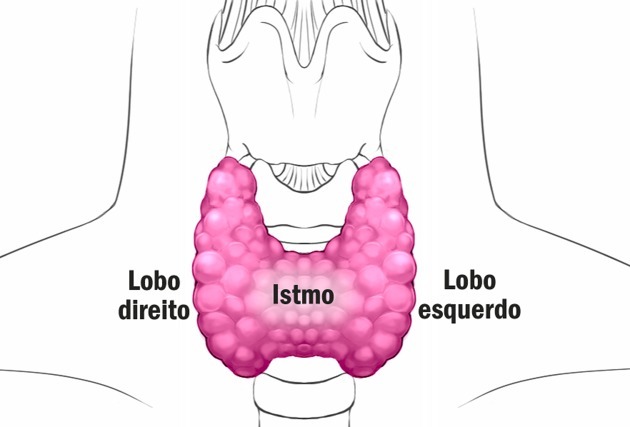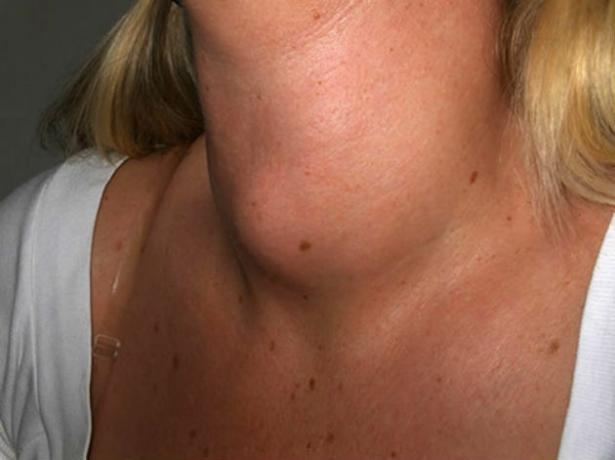THE thyroid it is a gland located in the neck region and with important functions in the regulation of vital organs.
It is responsible for the production of two important hormones, T3 (triiodothyronine) and T4 (thyroxine or tetraiodothyronine).
Thyroid anatomy and histology
The thyroid gland is located below the region known as the Adam's apple at the base of the neck. In an adult it can weigh up to 25 g.

It is small, about 5 cm, and butterfly-shaped, as it has two lobes attached to a central part.
The thyroid gland is lined with a connective tissue capsule.
Thyroid hormones
The thyroid produces two hormones, which are closely related to the regulation of the metabolism of our body. Hence, they are known as the body's metabolic hormones.
- T3 (tri-iodothyronine): Cell metabolism stimulator. It has more biological action, with a faster effect.
- T4 (thyroxine or tetraiodothyronine): Less active than T3.
The production of thyroid hormones is stimulated by the action of hypophysis, through the hormone TSH (thyrostimulant).
For hormone production, the thyroid needs iodine, which is obtained through food and water consumption. For this reason, iodine was added to table salt, as it was a more economical way for the entire population to have access to this element.
Importance of Thyroid
The hormones produced by the thyroid are responsible for regulating various functions in the body, such as:
- Growth and development of children and adolescents;
- Regulation of heart rate;
- Regulation of the menstrual cycle and fertility;
- Emotional control;
- Relation to weight gain and loss.
Thyroid problems
The thyroid may have problems with its function. Thus, the release of hormones occurs in excess (hyperthyroidism) or in small amounts (hypothyroidism). In addition, it is also affected by cancer or nodules.

hyperthyroidism
Hyperthyroidism is the excessive release of thyroid hormones, meaning the gland overworks.
The main causes of hyperthyroidism are: excessive consumption of iodine, Graves' disease (an alteration in the immune system that affects the thyroid) and the presence of thyroid nodules.
Hyperthyroidism symptoms
- Thyroid enlargement (goiter);
- Tachycardia;
- Increased appetite;
- Sudden mood swings;
- Excessive sweating;
- Sensation of heat;
- Tiredness;
- Frequent diarrhea;
- Trembling in the hands.
hypothyroidism
O hypothyroidism it is the decreased release of thyroid hormones.
Hypothyroidism Symptoms
- Thyroid enlargement (goiter);
- Hair loss;
- Decrease in heart rate;
- Changes in mood;
- Anemia;
- Fatigue;
- Joint pain;
- Muscle aches;
- Changes in the menstrual cycle;
- Commitment to growth.
Thyroid cancer
Thyroid cancer is a rare condition and the lack of signs of the disease can make it go unnoticed until the tumor has grown to a considerable size.
Some signs related to thyroid cancer are:
- Presence of nodule, perceived with touch;
- Pain in the neck and throat region;
- Hoarseness and voice changes;
- slimming;
- Swelling of the nodes in the neck.
In the thyroid, benign nodules can also appear, a situation more common than cancer. The disease is usually asymptomatic, but hormone production is compromised.
The nodule appears as a single or multiple, spread across the thyroid. In some cases, they produce thyroid hormones and their symptoms resemble those of hyperthyroidism.
Large lumps are usually noticed through difficulty in swallowing and the sensation of a lump in the throat.
Ultrasound is able to detect thyroid nodules. Medical follow-up is essential for treating the disease. Surgical intervention is indicated to remove the nodules.
Currently, there are great chances of cure for thyroid cancer and the problems related to benign nodules.
Read too: parathyroids
